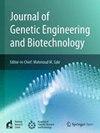Multiscale comparative pathogenomic analysis of Vibrio anguillarum linking serotype diversity, genomic plasticity and pathogenicity
IF 3.5
Q3 Biochemistry, Genetics and Molecular Biology
Journal of Genetic Engineering and Biotechnology
Pub Date : 2025-06-16
DOI:10.1016/j.jgeb.2025.100522
引用次数: 0
Abstract
Vibrio anguillarum is a major marine fish pathogen causing high mortality and potential zoonotic risks. Understanding its genomic diversity, virulence factors, and antibiotic resistance is crucial for aquaculture disease management. In this study, a comparative pan-genomic analysis of 16 V. anguillarum strains was conducted to examine core and accessory genome diversity, virulence factors, and antibiotic resistance mechanisms. The phylogenetic analysis was conducted using six core genes and SNPs to evaluate evolutionary relationships and pathogenic traits. The core genome contained 2,038 unique ORFs, while the accessory genome had 5,197 cloud genes, confirming an open pangenome. This study identified 118 pathogenic genomic islands, antibiotic resistance genes (tetracycline, quinolone, and carbapenem), and virulence factors, including type VI secretion system (T6SS) components and RTX toxins (hcp-2, vipB/mglB, rtxC). Core genes such as ftsI uncovered substantial evolutionary divergence among species, identifying more than 150 distinct SNPs. Phylogenetic analysis showed serotype-specific clustering, with O1 strains displaying genetic homogeneity, whereas O2 and O3 exhibited divergence, suggesting distinct evolutionary adaptations influencing pathogenicity and ecological interactions. These findings provide primary insights for developing molecular markers and targeted treatments for aquaculture pathogens.

鳗弧菌血清型多样性、基因组可塑性和致病性的多尺度比较病理分析
鳗弧菌是一种主要的海鱼病原体,具有高致死率和潜在的人畜共患风险。了解其基因组多样性、毒力因子和抗生素耐药性对水产养殖疾病管理至关重要。在这项研究中,对16株鳗弧菌进行了泛基因组比较分析,以研究核心和辅助基因组多样性、毒力因子和抗生素耐药机制。利用6个核心基因和snp进行系统发育分析,评价其进化关系和致病性状。核心基因组包含2038个独特的orf,而辅助基因组有5197个云基因,证实了一个开放的泛基因组。本研究鉴定了118个致病基因组岛、抗生素耐药基因(四环素、喹诺酮和碳青霉烯)和毒力因子,包括VI型分泌系统(T6SS)成分和RTX毒素(hcp-2、vipB/mglB、rtxC)。像ftsI这样的核心基因揭示了物种之间的进化差异,确定了150多个不同的snp。系统发育分析显示出血清型特异性聚类,其中O1菌株表现出遗传同质性,而O2和O3菌株表现出差异,表明不同的进化适应影响致病性和生态相互作用。这些发现为开发水产养殖病原体的分子标记和靶向治疗提供了初步见解。
本文章由计算机程序翻译,如有差异,请以英文原文为准。
求助全文
约1分钟内获得全文
求助全文
来源期刊

Journal of Genetic Engineering and Biotechnology
Biochemistry, Genetics and Molecular Biology-Biotechnology
CiteScore
5.70
自引率
5.70%
发文量
159
审稿时长
16 weeks
期刊介绍:
Journal of genetic engineering and biotechnology is devoted to rapid publication of full-length research papers that leads to significant contribution in advancing knowledge in genetic engineering and biotechnology and provide novel perspectives in this research area. JGEB includes all major themes related to genetic engineering and recombinant DNA. The area of interest of JGEB includes but not restricted to: •Plant genetics •Animal genetics •Bacterial enzymes •Agricultural Biotechnology, •Biochemistry, •Biophysics, •Bioinformatics, •Environmental Biotechnology, •Industrial Biotechnology, •Microbial biotechnology, •Medical Biotechnology, •Bioenergy, Biosafety, •Biosecurity, •Bioethics, •GMOS, •Genomic, •Proteomic JGEB accepts
 求助内容:
求助内容: 应助结果提醒方式:
应助结果提醒方式:


